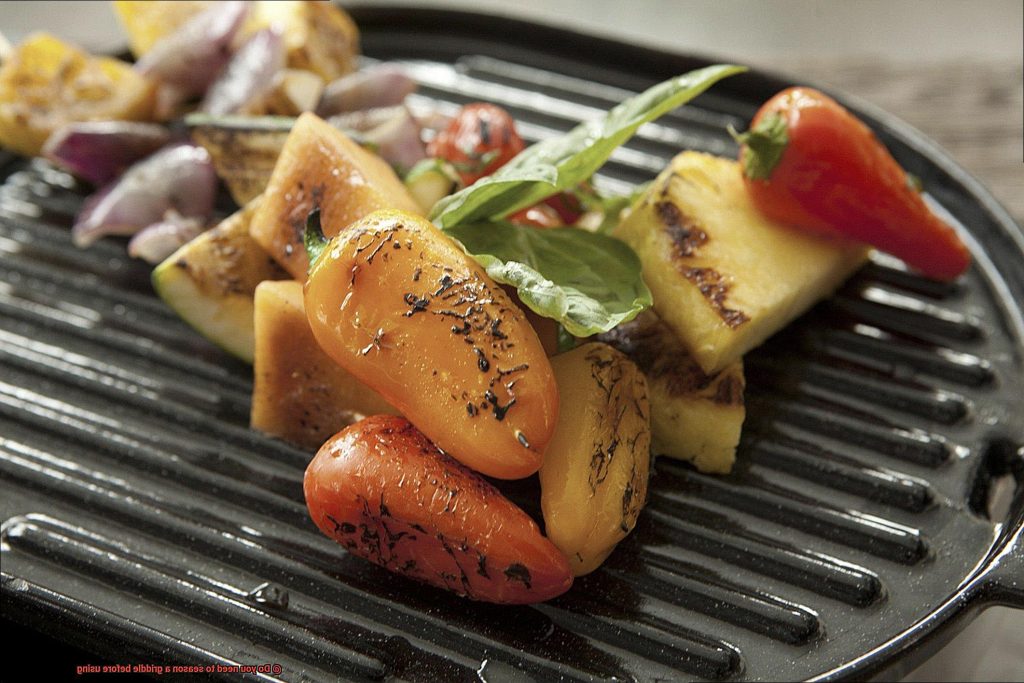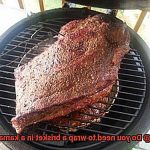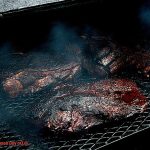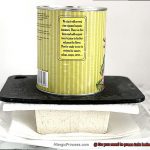Imagine this: a sizzle that could rival the crackling of a campfire, as your pancakes transform into golden perfection. Or picture a symphony of vibrant veggies dancing on your griddle, infused with an irresistible smoky essence. These mouthwatering delights aren’t just the result of culinary prowess; they owe their magic to a little-known secret: seasoning your griddle before use.
While seasoned chefs and grill gurus swear by this age-old tradition, many cooking novices remain oblivious to its power. Whether you’ve splurged on a shiny new griddle or are resurrecting an old faithful from storage, it’s time to unlock the wonders of seasoning and revolutionize your cooking adventures.
In this blog post, we’ll immerse ourselves in the art of griddle seasoning, uncover its boundless benefits, and arm you with the knowledge and techniques required for an extraordinary culinary journey. So grab your aprons, wield those spatulas, and let’s embark on a tantalizing exploration of the enchanted realm of seasoned griddles.
Contents
Benefits of Seasoning a Griddle
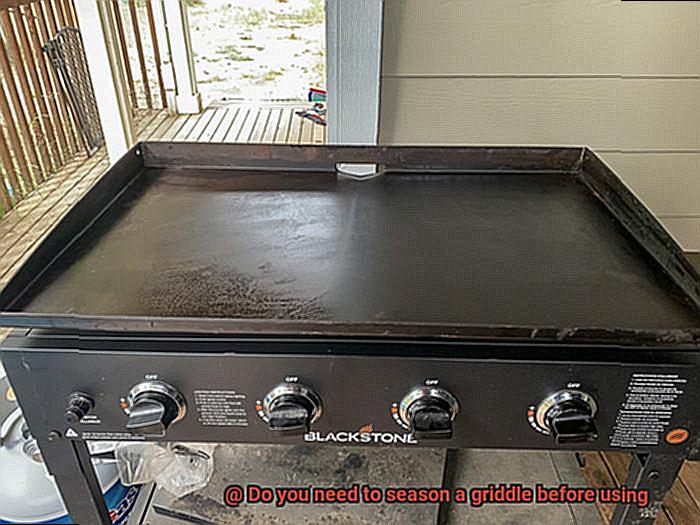
The Art of Seasoning: Elevating Your Griddle Game
Griddling is a beloved cooking technique that delivers mouthwatering results. However, to truly take your griddle game to the next level, one key step is often overlooked: seasoning. Seasoning a griddle involves treating the surface with oil or fat to create a non-stick coating and prevent rusting. In this article, we’ll explore the numerous benefits of seasoning your griddle and why it’s worth the extra effort.
First and foremost, seasoning creates a slick, non-stick surface that prevents food from sticking. Imagine effortlessly flipping pancakes, eggs, or delicate fish fillets without any mishaps. The result? Perfectly cooked food that effortlessly slides off the griddle.
But it doesn’t stop there. Seasoning also prevents rust and corrosion, extending the lifespan of your griddle. Griddles are susceptible to damage when exposed to moisture, but by seasoning your griddle, you create a protective layer that shields the metal from oxidation. This means your griddle will remain in top-notch condition for years to come.
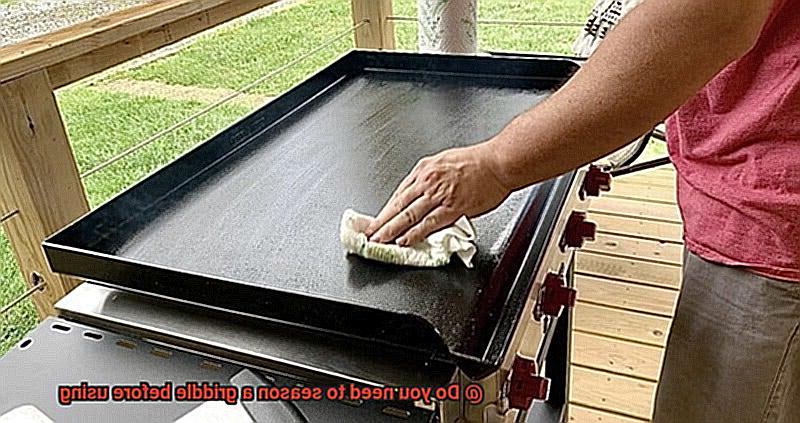
Now let’s talk flavor. Seasoning imparts a natural smoky taste to your dishes, enhancing their flavor profile. As the oil or fat seeps into the cooking surface, it infuses your food with delicious nuances that will have your taste buds singing.
But it’s not just about taste; it’s about performance too. A well-seasoned griddle heats up evenly, eliminating hotspots and ensuring consistent cooking results. Say goodbye to unevenly cooked steaks or burnt spots on your veggies.
And here’s a bonus benefit: reduced oil usage. Seasoning creates a barrier between the griddle and the food, reducing the need for excessive oil or cooking spray. This not only promotes healthier cooking but also saves you money in the long run.
Cleaning and maintenance become a breeze with a seasoned griddle. Food particles are less likely to stick to the surface, meaning you spend less time scrubbing and more time enjoying your delicious creations.
Let’s not forget the visual aspect. A seasoned griddle boasts a beautiful, shiny surface that gives off a professional vibe. Impress your guests with a griddle that looks as good as it cooks.
And speaking of cooking, seasoning helps your griddle handle higher temperatures without warping or damaging the surface. This is especially important for searing steaks or achieving the perfect char on your burgers.
But there’s more. Seasoning your griddle before use helps remove any manufacturing residues or impurities that may be present on the surface, ensuring a clean and safe cooking environment.
Lastly, seasoning your griddle can be an enjoyable and rewarding experience. It allows you to personalize your cooking equipment and connect with the art of griddling on a deeper level.
Different Oils to Use for Seasoning
Unlock the full potential of your griddle by embarking on the art of seasoning, transforming it into a slick, non-stick masterpiece that not only enhances flavor, prevents rust, and promotes even cooking but also adds a touch of elegance to your culinary creations.
When it comes to seasoning a griddle, the type of oil you use plays a crucial role. Not only does it help create a non-stick surface, but it also adds a burst of flavor to your food. Let’s explore some of the different oils that can be used for seasoning a griddle.
- Vegetable Oil: With its high smoke point and neutral flavor, vegetable oil is a popular choice for seasoning a griddle. It forms a durable layer on the surface, preventing food from sticking and ensuring even heat distribution. This readily available and affordable option is a convenient choice for many grill enthusiasts.
- Canola Oil: Another excellent choice is canola oil, which boasts a high smoke point and neutral taste. Low in saturated fat and rich in omega-3 fatty acids, it offers heart-healthy benefits. Canola oil provides a smooth and non-stick surface, making it perfect for hassle-free cooking.
- Flaxseed Oil: Known for its high smoke point and ability to form a strong seasoning layer, flaxseed oil adds a unique nutty flavor to your food. Rich in omega-3 fatty acids and antioxidants, it is a healthy option for seasoning your griddle.
- Coconut Oil: If you desire a natural and tropical flavor in your dishes, coconut oil is an excellent choice for seasoning. With its high smoke point, it imparts a subtle coconut taste to your food. Additionally, coconut oil possesses antimicrobial properties that help keep your griddle clean and hygienic.
- Avocado Oil: Increasingly popular for seasoning griddles, avocado oil boasts a high smoke point and numerous health benefits. Rich in heart-healthy monounsaturated fats, it has a mild and buttery flavor that enhances the taste of your food without overpowering it.
- Olive Oil: While commonly used for cooking, olive oil may not be the best choice for seasoning a griddle due to its low smoke point. However, if you still prefer to use olive oil, opt for extra virgin olive oil as it has a higher smoke point compared to other varieties.
Remember to choose oils with high smoke points to prevent them from breaking down and becoming rancid during the seasoning process. Always apply a thin, even layer of oil to the griddle and allow it to heat up gradually, creating a durable non-stick coating.
Steps for Seasoning a Griddle
Seasoning a griddle is a crucial step in preparing it for cooking. Not only does it create a non-stick surface, but it also prevents rusting, ensuring your griddle lasts for years to come. So, let’s dive into the art of griddle seasoning and explore the steps to achieve that perfect cooking surface.
Step 1: Cleanse the Griddle
Before embarking on the journey of griddle seasoning, start with a clean slate. Give your griddle a thorough scrub with soap and water or use a grill brush to remove any lingering food particles or debris. This step ensures your griddle is free from unwanted flavors and allows the oil to penetrate evenly.
Step 2: Dry Thoroughly
Once your griddle is squeaky clean, make sure it’s bone dry. Any moisture left behind can lead to rusting, and we definitely don’t want that. So take the time to dry it thoroughly before moving on to the next step.
Step 3: Embrace the Oil
Now comes the fun part – applying the oil. Choose an oil with a high smoke point, such as vegetable oil, canola oil, or flaxseed oil. These oils can withstand high temperatures without breaking down and creating unpleasant odors or flavors. Using a paper towel or a brush, spread a thin layer of oil across the entire surface of the griddle. This will create a protective barrier and help prevent sticking.
Step 4: Ignite the Heat
Time to fire up the griddle. Set the heat to high and let it preheat for about 10-15 minutes. This process helps open up the pores of the metal and allows the oil to seep in, creating that beautiful non-stick surface we’re after. You may notice some smoke during this step, which is completely normal. Just make sure you have good ventilation in your cooking area.
Step 5: Cool Down and Solidify
Once you’ve heated your griddle, turn off the heat and let it cool down completely. This is crucial as it allows the oil to solidify and form that protective coating we mentioned earlier. It’s like giving your griddle a cozy blanket for added protection.
Step 6: Repeat the Ritual
Depending on the condition of your griddle, you may need to repeat the seasoning process a few times. Brand new griddles or those that haven’t been used in a while may require a couple of rounds of seasoning to build up that perfect non-stick surface. Just remember to apply a thin layer of oil each time and follow the previous steps.
Step 7: Maintain the Magic
To keep your griddle in optimal condition, regular maintenance is key. After each use, clean the griddle with a grill brush or sponge and warm water. Dry it thoroughly to prevent rusting. Before storing, apply a thin layer of oil to maintain the non-stick surface.
How Often Should You Re-Season?
So, you’ve just invested in a brand new griddle and you’re ready to start grilling up a storm. But before you dive into your favorite recipes, there’s one important step you shouldn’t overlook – seasoning your griddle. Seasoning is like giving your griddle a cozy blanket of protection, creating a non-stick surface and preventing rust, ensuring your griddle lasts for years to come. But how often should you re-season? Let’s dive in and find out.
Factors that Influence Re-Seasoning:
The frequency of re-seasoning largely depends on how often you use your griddle, the type of food you cook, and your cleaning methods. Generally, it’s recommended to re-season every few months or as needed. However, if you’re a grilling enthusiast who fires up your griddle on a daily basis or cooks sticky and greasy foods, you may need to re-season more often.
Signs it’s Time to Re-Season:
How do you know when it’s time to re-season? Keep an eye on your griddle’s performance. If you notice that food is starting to stick to the surface or if your once perfect pancakes are turning into pancake disasters, it’s a good sign that it’s time to re-season. Additionally, any signs of rust or discoloration on the griddle are also indicators that re-seasoning is necessary.
The Re-Seasoning Process:
To begin the re-seasoning process, give your griddle a thorough cleaning with warm soapy water and a non-abrasive sponge. Rinse it well and make sure it’s completely dry. Next, apply a small amount of oil or fat onto the griddle’s surface. You can use vegetable oil, canola oil, flaxseed oil – any oil with a high smoke point will work. Spread the oil evenly using a paper towel or brush, making sure to cover all areas of the griddle. Now it’s time to heat things up. Turn the heat to medium-high and let the griddle heat for about 15-20 minutes. This allows the oil to bond with the metal, creating that beautiful non-stick surface we all crave.
Proper Care for Longevity:
In addition to regular re-seasoning, it’s important to take proper care of your griddle to ensure its longevity. Avoid using metal utensils or abrasive cleaning tools that can scratch the surface and remove the seasoning. Instead, opt for wooden or silicone utensils and gentle cleaning methods.
Does Your Griddle Require Seasoning?
Today, we dive into the sizzling topic of griddle seasoning. The question on everyone’s minds is: does your griddle require seasoning? Well, prepare to be enlightened because we’ve got all the juicy details for you.
First and foremost, let’s clarify what seasoning means in this context. We’re not talking about adding salt and pepper (although those are important too.). When we mention seasoning a griddle, we’re referring to the process of coating the griddle’s surface with a layer of oil or fat and heating it up. Think of it as giving your griddle a cozy blanket of protection.
Now, you may wonder why you should go through the trouble of seasoning your griddle. Well, my friends, the benefits are scrumptious. Firstly, seasoning prevents food from sticking to the griddle. No one wants their perfectly flipped pancakes or succulent burgers to get stuck and torn apart. A well-seasoned griddle ensures easy flipping and an even cook every time.
But wait, there’s more. Seasoning also promotes even heat distribution, which is essential for achieving those mouthwatering grill marks and perfectly cooked veggies. It’s like creating a hot spot-free zone on your griddle. Additionally, if you happen to own a cast iron griddle, seasoning is crucial to prevent rusting and maintain its non-stick properties.
Now, let’s get down to the sizzle-worthy facts. While cast iron griddles require regular seasoning, stainless steel griddles don’t necessarily need it but can still benefit from it. Cast iron craves that extra layer of oil to keep it rust-free and non-stick, while stainless steel appreciates the improved non-stick capabilities that seasoning brings.
So how do you go about seasoning your griddle? For cast iron, start by giving it a thorough cleaning with hot water and a brush to remove any dirt or residue. Dry it completely before applying a thin layer of oil or fat all over the surface. Opt for oils like vegetable, canola, or flaxseed. Then, heat the griddle on medium-high heat for about 15-20 minutes to let that oil bond with the surface. Repeat this process a few times to build up a strong seasoning.
As for stainless steel griddles, the process is similar. Clean it up, apply a thin layer of oil, and heat it on medium-high heat for several minutes. This will help create a non-stick surface and improve heat distribution.
Remember, after each use, clean your griddle properly to maintain its seasoning. Avoid harsh detergents and scrubbing pads that can strip away the seasoning. Instead, use a mild dish soap and a soft sponge or brush. Once it’s clean, dry it thoroughly to prevent rusting.
Tips for Maintaining the Non-Stick Surface of a Griddle
A well-maintained non-stick griddle is the secret weapon you need. In this blog post, we will explore the importance of proper maintenance for your griddle’s non-stick surface and provide you with essential tips to keep it in tiptop shape. So grab your apron and spatula, and let’s dive in.
Regular Cleaning:
To preserve the non-stick surface of your griddle, regular cleaning is crucial. After each use, allow the griddle to cool down completely before gently scrubbing away any food residue or grease using a soft sponge or cloth. Harsh abrasives or metal brushes should be avoided as they can scratch the non-stick coating. Treat your griddle with care, and it will reward you with effortless food release.
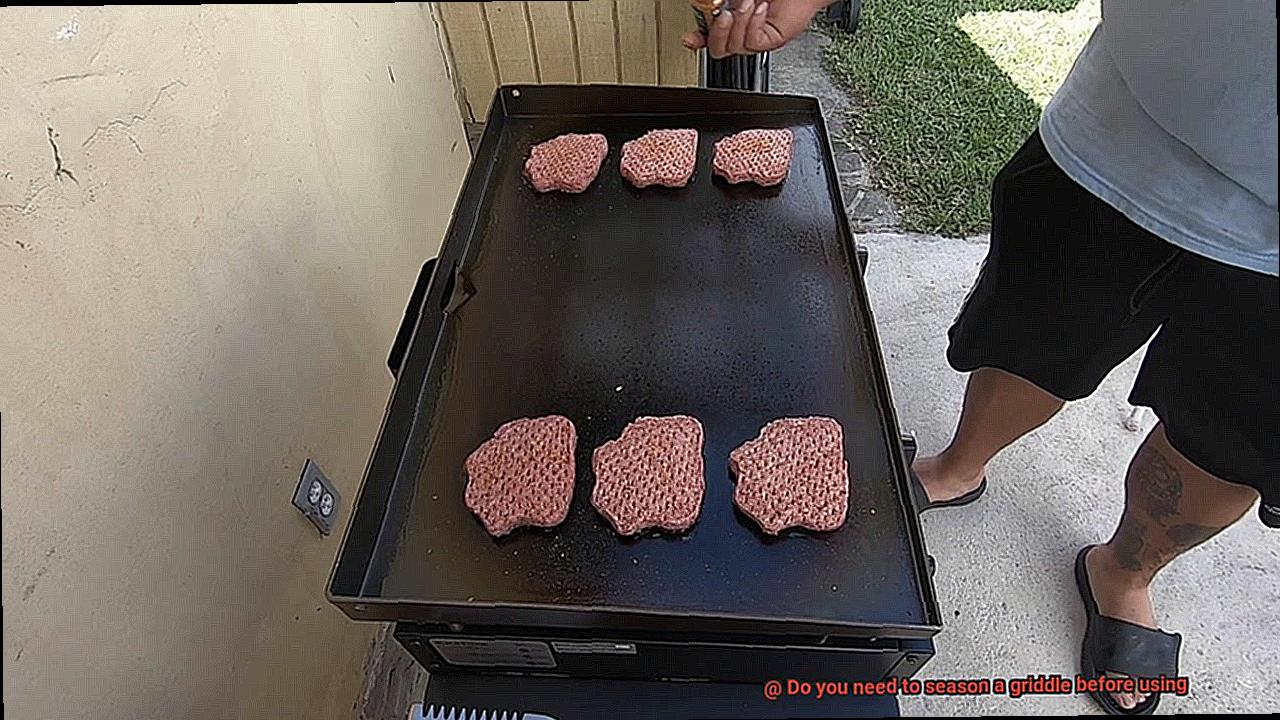
Utensil Use:
Metal tools may be tough, but they are not suitable for your non-stick griddle. Opt for wooden or plastic utensils instead, as they are gentle on the non-stick surface and less likely to cause damage or scratches. Let these gentle giants be your cooking companions, ensuring that your griddle remains in pristine condition.
Avoiding Acidic Foods:
While tomatoes and citrus fruits add a zesty touch to our dishes, they can be corrosive to the non-stick coating of your griddle. To protect your precious surface, consider using a parchment paper or aluminum foil as a barrier between these acidic foods and your griddle. This way, you can still enjoy that tangy flavor without compromising your griddle’s performance. Shield your griddle from the wrath of acidity.
Seasoning:
Picture this: sizzling sounds, mouthwatering aromas, and perfectly cooked food gliding effortlessly off your griddle. How can you achieve this grilling nirvana? Seasoning. By applying a thin layer of oil onto your griddle’s surface and heating it until it forms a protective layer, you can enhance its performance and prolong its lifespan. Just follow the manufacturer’s instructions for best results. Season your griddle with love, and it will reward you with culinary perfection.
Storage:
After cleaning your griddle, ensure it is stored in a cool and dry place to prevent moisture or humidity from causing damage. If possible, use a protective cover or wrap it in a soft cloth to shield it from scratches or dents. Treat your griddle like the superstar it is. Proper storage will keep your griddle in top-notch condition, ready to serve up mouthwatering meals time after time.
VspmDVnj2pI” >
Conclusion
In conclusion, seasoning a griddle before using is highly recommended.
By applying a thin layer of oil and heating it, you create a non-stick surface that enhances the cooking experience. The process not only prevents food from sticking but also adds flavor to your dishes.
It’s like giving your griddle a little TLC before it gets to work. So, don’t skip this step.
Take the time to season your griddle and enjoy the benefits of effortless cooking and delicious results.

